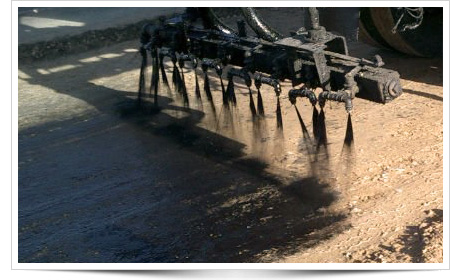Surface King Tack & Prime Coat Applications With Asphalt Emulsions

Prime Coat
Prime coats protect the integrity of the granular base during construction and help reduce dust. In the case of a base that is to be covered with a thin hot mix layer or a chip seal for a low-volume roadway, priming ensures a good bond between the seal and the underlying surface which otherwise would have a tendency to delaminate.
Slow-setting grades of asphalt emulsions (diluted with water before application) are a suitable type of emulsion is most suitable prime. With dense granular bases, or stabilized bases the surface may need to be broken up by scarifying before application, to ensure good penetration.
A prime coat performs several important functions.
- The major purpose of a prime coat is to protect the underlying layers from wet weather by providing a temporary waterproofing layer.
- Additional benefits of prime coat are stabilizing or binding the surface fines together and promoting a bond to the HMA layer.
- Prime must adequately penetrate the base to function properly.
- Medium cure cutbacks are normally used for prime. Medium cure cutback asphalts penetrate deeper than conventional emulsified asphalts. Dilution of emulsified asphalts with water helps penetration but emulsified asphalts generally require mixing into the base to function properly.
- Prime coats need to be allowed to cure completely before covering with HMA. Cutbacks generally take longer to cure than asphalt emulsions.
- Excess prime not absorbed into the base after 24 hours should be absorbed with blotter sand and removed from the surface.
- Prime is often deleted in cold weather because it is riskier to pave over uncured prime than over an unprimed base.
- Prime coats are often deleted if no wet weather is anticipated and the base can be covered within seven days. Prime may not be necessary if the HMA is greater than 100 mm (4 in) thick.
- A prime coat increased the bond strength at the interface between a compacted base and asphalt layer over that of no prime coat. The reported differences were not always statistically significant.
- At higher static normal stresses, shear strength at the interface is not appreciably affected by the type or even the presence of a prime coat. This supports the practice of deleting prime at a minimum HMA thickness, typically 100 mm (4 in).
- The use of a prime coat is not a substitute for maintaining the specified condition of the base or subgrade.
Prime should not be applied to stabilized bases or subgrade. - The main environmental concern with prime coat applications is air pollution associated with the release of VOCs into the air.
- The EPA treats spills of cutbacks and emulsified asphalts the same; therefore, priming with emulsified asphalts or specially formulated penetrating asphalt emulsions does not result in reduced oil spill reporting regulations or requirements.
- Deleting prime would lessen the amount of liquid asphalt contractors must handle, lessening the associated liability with handling these products.
- Prime may be omitted if there is a strong possibility of runoff entering a waterway.
Tack Coat
Tack coat (also known as bond coat) is a light spray application of diluted asphalt emulsion between hot mix asphalt layers designed to create a strong adhesive bond without slippage. Heavier applications may be used under porous layers or around patches where it also functions as a seal coat. Without tack coat the asphalt layers in a roadway may separate which reduces the structural integrity of the road and may also allow water to penetrate the structure.
The type of emulsion used for tack coats varies from country to country. Normal practice in the USA is to use a slow-setting emulsion that is diluted with water before application. In many European countries cationic rapid setting or specially designated low viscosity medium setting emulsions are used, which are applied undiluted.
The functions performed by Tack Coat are:
- The purpose of a tack coat is to ensure a bond between the existing pavement surface and a new pavement surface.
- A loss of bond between HMA layers can cause crescent-shaped slippage cracks or debonding to occur, leading to reduced pavement life.
- Prior to tack application, the surface should be clean, dry, and free from loose material.
- Applying tack is not a substitute for properly cleaning the existing HMA surface.
- Tack coat should be applied in a thin coat and uniformly cover the entire surface, including all vertical surfaces of joints and structures. Too little tack coat can cause debonding and too much tack coat can cause slippage.
- If possible, all traffic should be kept off tacked surfaces.
- Tack should be applied to old existing HMA surfaces and PCC surfaces.
- Tack has been successfully deleted between new lifts of HMA when the existing surface is still clean and tacky.
- There is no complete agreement regarding the requirement that the tack coats be allowed to break and set before placing the HMA layer.
- Many factors were shown to affect laboratory interface shear strength, including the rate of shear, the magnitude of normal force, temperature, and joint construction.
- In a few studies, tacked surfaces were shown to have slightly lower interface shear strengths than untacked surfaces. However, in these studies, the statistical significance of the difference in interface shear strength was not reported. In reports where the statistical significance of the differences in interface shear strength was evaluated, tacked interfaces were either stronger or not significantly different from untacked interfaces.
- The higher the viscosity of the bituminous binder in the tack, the higher the reported interface shear strength.
- At typically specified application rates, application rate had little effect on interface shear strength. Higher than recommended application rates resulted in slightly lower interface shear strengths.
- Diluted slow set emulsions are typically used for tack coat.
Address
8803 Futures Dr., Suite 2
Orlando, FL 32819-9076
Phone & Fax
Phone: (407) 855-5959
Fax: (888) 389-8173
Office Hours
Weekday: 8 AM – 6 PM
Weekends: By Appointment


